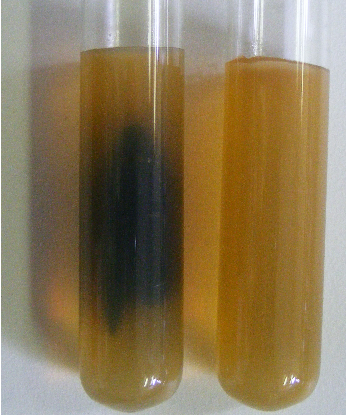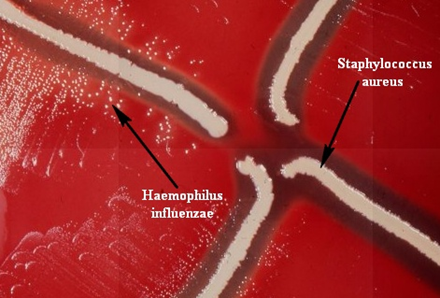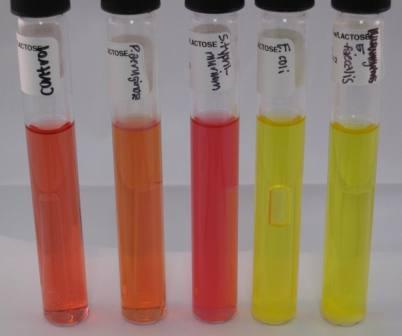Hydrogen sulphide test: Hydrogen sulphide test is used to identify bacteria that produce the gas, hydrogen sulphide (H2S). Hydrogen sulphide (H2S) production test is used for the detection of hydrogen sulphide (H2S) gas produced by an organism. H2S is produced by bacteria during the anaerobic metabolism of sulphur containing amino acids (e.g. cysteine).
This gas (H2S) is also produced from the reduction of inorganic sulphur compounds such as sulphides and sulphites with ferrous, ferric and lead salts. Hydrogen sulphide test is used mainly to assist in the identification of members of the family Enterobacteriaceae and occasionally to differentiate other bacteria such as Bacteroides species and Brucella species.
H2S gas is produced when sulphur – containing amino acids are decomposed. This test can be performed in many ways using different biochemical reagents including indicator paper, sulphite indole motility (SIM) medium, Kligler iron agar (KIA), triple sugar iron agar (TSIA) and Lead acetate paper.
PROCEDURE FOR HYDROGEN SULPHIDE TEST USING LEAD ACETATE PAPER
- Prepare indicator paper by cutting Whitman filter paper No. 1 into long strips.
- Soak the filter paper in saturated lead acetate solution.
- Prepare the basal medium (e.g. nutrient broth or sterile peptone water) by adding 0.01 % cysteine to peptone H2O or nutrient broth.
- Distribute the prepared basal medium into 10 ml portions in test tubes.
- Inoculate each test tube with a loopful of the test bacteria while leaving one of the tubes uninoculated. This uninoculated tube will serve as the negative control tube.
- Insert a strip of lead acetate indicator paper between plug and glass in such a way that the indicator paper stays just above the medium.
- Incubate the medium at 37oC for 18-24 hrs. Observe the tubes containing the indicator paper for H2S production. H2S production normally develops during the incubation period of the agar medium. The blackening of the lead acetate indicator paper indicates H2S production and this shows a positive test result. Absence of the blackening of the lead acetate indicator paper shows a negative test result (Figure 1 & Figure 2). Proteus vulgaris is H2S positive while Shigella species is H2S negative.


References
Basic laboratory procedures in clinical bacteriology. World Health Organization (WHO), 1991. Available from WHO publications, 1211 Geneva, 27-Switzerland.
Beers M.H., Porter R.S., Jones T.V., Kaplan J.L and Berkwits M (2006). The Merck Manual of Diagnosis and Therapy. Eighteenth edition. Merck & Co., Inc, USA.
Biosafety in Microbiological and Biomedical Laboratories. 5th edition. U.S Department of Health and Human Services. Public Health Service. Center for Disease Control and Prevention. National Institute of Health. HHS Publication No. (CDC) 21-1112.2009.
Cheesbrough M (2010). District Laboratory Practice in Tropical Countries. Part I. 2nd edition. Cambridge University Press, UK.
Cheesbrough M (2010). District Laboratory Practice in Tropical Countries. Part 2. 2nd edition. Cambridge University Press, UK.
Collins C.H, Lyne P.M, Grange J.M and Falkinham J.O (2004). Collins and Lyne’s Microbiological Methods. Eight edition. Arnold publishers, New York, USA.
Disinfection and Sterilization. (1993). Laboratory Biosafety Manual (2nd ed., pp. 60-70). Geneva: WHO.
Garcia L.S (2010). Clinical Microbiology Procedures Handbook. Third edition. American Society of Microbiology Press, USA.
Garcia L.S (2014). Clinical Laboratory Management. First edition. American Society of Microbiology Press, USA.
Fleming, D. O., Richardson, J. H., Tulis, J. I. and Vesley, D. (eds) (1995). Laboratory Safety: Principles and practice. Washington DC: ASM press.
Dubey, R. C. and Maheshwari, D. K. (2004). Practical Microbiology. S.Chand and Company LTD, New Delhi, India.
Gillespie S.H and Bamford K.B (2012). Medical Microbiology and Infection at a glance. 4th edition. Wiley-Blackwell Publishers, UK.
Discover more from Microbiology Class
Subscribe to get the latest posts sent to your email.




